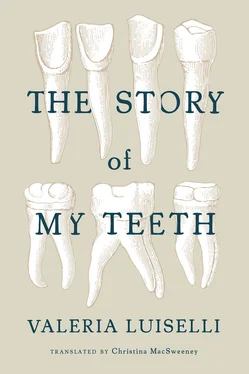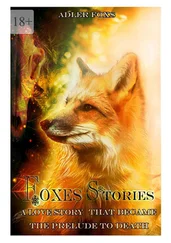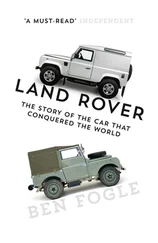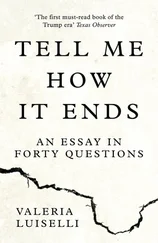Valeria Luiselli - The Story of My Teeth
Здесь есть возможность читать онлайн «Valeria Luiselli - The Story of My Teeth» весь текст электронной книги совершенно бесплатно (целиком полную версию без сокращений). В некоторых случаях можно слушать аудио, скачать через торрент в формате fb2 и присутствует краткое содержание. Год выпуска: 2015, Издательство: Coffee House Press, Жанр: Современная проза, на английском языке. Описание произведения, (предисловие) а так же отзывы посетителей доступны на портале библиотеки ЛибКат.
- Название:The Story of My Teeth
- Автор:
- Издательство:Coffee House Press
- Жанр:
- Год:2015
- ISBN:нет данных
- Рейтинг книги:5 / 5. Голосов: 1
-
Избранное:Добавить в избранное
- Отзывы:
-
Ваша оценка:
- 100
- 1
- 2
- 3
- 4
- 5
The Story of My Teeth: краткое содержание, описание и аннотация
Предлагаем к чтению аннотацию, описание, краткое содержание или предисловие (зависит от того, что написал сам автор книги «The Story of My Teeth»). Если вы не нашли необходимую информацию о книге — напишите в комментариях, мы постараемся отыскать её.
Highway is a late-in-life world traveler, yarn spinner, collector, and legendary auctioneer. His most precious possessions are the teeth of the "notorious infamous" like Plato, Petrarch, and Virginia Woolf. Written in collaboration with the workers at a Jumex juice factory,
is an elegant, witty, exhilarating romp through the industrial suburbs of Mexico City and Luiselli's own literary influences.
Valeria Luiselli
New York Times, Granta
McSweeney's
The Story of My Teeth — читать онлайн бесплатно полную книгу (весь текст) целиком
Ниже представлен текст книги, разбитый по страницам. Система сохранения места последней прочитанной страницы, позволяет с удобством читать онлайн бесплатно книгу «The Story of My Teeth», без необходимости каждый раз заново искать на чём Вы остановились. Поставьте закладку, и сможете в любой момент перейти на страницу, на которой закончили чтение.
Интервал:
Закладка:
I transcribed his stories, and my old roommates printed them in small chapbooks on their press at the Rincón Cultural [figure 2]. Highway never saw them, but I’m sure he would have felt proud. In exchange for my work as a transcriber, Highway not only gave me board and lodging, but also an education. He took me for daily walks or bicycle rides around the streets of Ecatepec, as he was convinced that, one day, I could become the first tour guide in the area. Initially, the idea seemed foolish. If there is a physical materialization of nothingness in this world, it is Ecatepec de Morelos. But with time, I have come to believe that in this case, as with almost everything else, Highway was right. Through his stories, Ecatepec became habitable for me, so perhaps one day, if I tell those stories, it will become a place that others visit.
On the day we met, after picking up my few belongings from the apartment I shared with Darling and Understanding, we cycled to Highway’s house on Disneylandia [figures 3 and 4]. The first place we went on entering the grounds was his warehouse. He ushered me in as if we were entering some kind of temple. Highway moved slowly around the space in silence, the indented trace of a toothless smile on his face. I followed a few steps behind him. Pointing to empty corners, he described objects, none of which were actually there: collections of teeth, of course, but also antique maps, car parts, Russian dolls, newspapers in every imaginable language, old coins, nails, bicycles, bells, doors, belts, sweaters, stones, sewing machines. He gave me a febrile tour of what he called his grand collection of collectibles. It’s hard to say if those were sad or luminous moments.
Highway had once possessed an unimaginably diverse and rich collection. He was a man who truly loved material objects. And his love for them went beyond their real, material worth; for him, their value lay in that thing that, in some way, they silently enclosed. From a very early age, he had followed his impulse to meticulously collect everything he thought collectible, from coins he found on the sidewalk and buttons that fell off his schoolmates’ shirts, to his father’s nails and his mother’s hair.
Late, but not too late, when he was forty-two, he discovered his true vocation in auctioneering. At that time he had been living with Flaca for a couple of years, and his son Siddhartha was still a dribbling infant. His whole life was ahead of him. But when Highway went to the United States with a grant to do an advanced course in auctioneering, Flaca left him. During his absence, the lady had met a recalcitrantly Catholic man from Yucatán of her own social class, and had moved in with him, taking Siddhartha with her. She died a few years later, but, in her will, she had laid out that Siddhartha should be raised by his stepfather. I imagine that Highway did not know enough about the law to realize that Flaca’s testamentary disposition had no legal value whatsoever. It is my impression that Highway never recovered from the blow all this entailed, although he did have sufficient emotional resources to set aside the pain.
Despite all his training and innate talent for the art of auctioneering, when he returned to Mexico, Highway had, in fact, little luck in the profession. He took out a loan to buy a small plot in the neighborhood where he was born and built a colorful but almost uninhabitable house in Calle Disneylandia. This was Highway’s home for more than two decades. Next to the house, Highway constructed a warehouse, above which he placed a placard he had custom-made, saying: Oklahoma-Van Dyke Auction House.
Highway remained in his house, practically in a form of self-imposed exile, for the two following years. He only went out to buy tinned food at the corner shop, and a variety of objects in the yard belonging to the famous junk collector Jorge Ibargüengoitia [figure 5]. Every week, Highway would buy, exchange, or scavenge objects that caught his eye and, on some Sundays, organized private auctions in his house. But these forays were never completely formalized. The Sunday auctions were attended, if at all, by morbidly curious neighbors, vagabonds, and drunks. No one bought anything, so the warehouse gradually filled up with useless objects. This must have depressed Highway more than he himself knew.
Time passed, and one day a well-meaning neighbor on Disneylandia, Carlos Velázquez, contacted Siddhartha to say that Highway’s “popcorn had popped.” He was on his last legs, so to speak. Apparently, he no longer left the house for either food or objects. Sometimes he sat in the sun in an Acapulco chair placed outside the front door of the house. He would spend long hours there, motionless, staring into space or, occasionally, polishing some item of his collection with a cloth. According to another neighbor, Laia Jufresa, Highway had a moribund, almost cadaverous look: “His eyes were like a pair of bare lightbulbs, the white fluorescent kind.” His days were numbered.
Siddhartha, an ambitious rat of the worst type, saw this as an opportunity to get hold of his father’s collection, not so much because he thought it valuable, but because he thought it folkloric enough to make a good statement. Like most curators, he too wanted to have work of his own — and what better place to start than this? Knowing he would get nowhere on his own, he resolved to talk to the local priest. He suggested holding an auction, the revenues of which would benefit the church to a reasonable percentage. When he in turn heard of Highway’s plight, Father Luigi Amara, of Saint Apolonia Church, saw an opportunity to kill two birds with one stone: raising funds and raising funds. He paid a visit to Highway one morning and proposed that they undertake a “joint auction.” They shook on it.
A few days before the auction, Siddhartha handed Father Luigi a will for Highway to sign, in which it was stated that our hero would bequeath his whole collection of collectibles to his son. Highway signed the document without even reading it on the morning of the auction, while waiting for his cue in the church sacristy. I will never know for certain if he realized that, with that signature, he was handing over his whole life to Siddhartha. But after so much time mulling it over, my impression is that he somehow did. That would also explain the elegant irony with which Highway, once all the lots had been auctioned, looked Siddhartha straight in the eyes and asked, Who will open the bidding for me and my teeth?
Indeed, on the day before the morning when we first met, Highway and his teeth had been bought in an auction at a bargain price by his son Siddhartha Sánchez Tostado. There are various versions of what happened next. One goes that, after the auction, Siddhartha pumped him full of narcotics, and, when poor Highway fell into a deep, indefinitely long sleep, he took him to a dental dispensary where a pair of doctors removed his precious teeth. Another version says that when the auction was over, the father and son went to a cantina to settle scores, and, at the height of their drunken binge, while Siddhartha was trying to haul his father back to the car, Highway hit the tarmac so often that he simply lost the teeth. It seems unlikely. Although Highway always refused to tell me which of the two accounts of that day was true, perhaps simply because he had no clear memory of it, I think that the first version is the correct one: it was those sinister doctors who, on the orders of the even more fiendish Siddhartha, removed his teeth.
What is completely certain, as there is videotaped evidence to prove it, is that on the evening of the day of the auction, Siddhartha deposited his father in one of the salons in the Jumex art gallery. To be exact, Siddhartha dumped Highway in a room, on the four walls of which were a video-installation showing four clowns observing the viewer with a complete lack of interest, only periodically blinking or sighing — a somewhat frightening but effective piece by the well-known artist Ugo Rondinone [figure 6]. After abandoning his father in front of Rondinone’s clown installation, Siddhartha went to the room where the gallery’s audiovisual security equipment was housed and proceeded to hold a remote conversation with his father through one of the loudspeaker systems. Conversation is one way of putting it: Siddhartha did his level best to torture and torment his father, and recorded it, probably for future use. He commissioned him to run a series of whimsical errands, such as finding monographs on the Russian Revolution and a white vw. But our local hero was made of sterner stuff. When the unbreakable Highway was finally able to summon up sufficient energy to leave the “room of ghosts,” as he often referred to the place when recounting the anecdote, he mounted a bicycle and pedaled off into the sunrise along that now legendary street, Sonora Oriente, where our paths luckily crossed.
Читать дальшеИнтервал:
Закладка:
Похожие книги на «The Story of My Teeth»
Представляем Вашему вниманию похожие книги на «The Story of My Teeth» списком для выбора. Мы отобрали схожую по названию и смыслу литературу в надежде предоставить читателям больше вариантов отыскать новые, интересные, ещё непрочитанные произведения.
Обсуждение, отзывы о книге «The Story of My Teeth» и просто собственные мнения читателей. Оставьте ваши комментарии, напишите, что Вы думаете о произведении, его смысле или главных героях. Укажите что конкретно понравилось, а что нет, и почему Вы так считаете.












